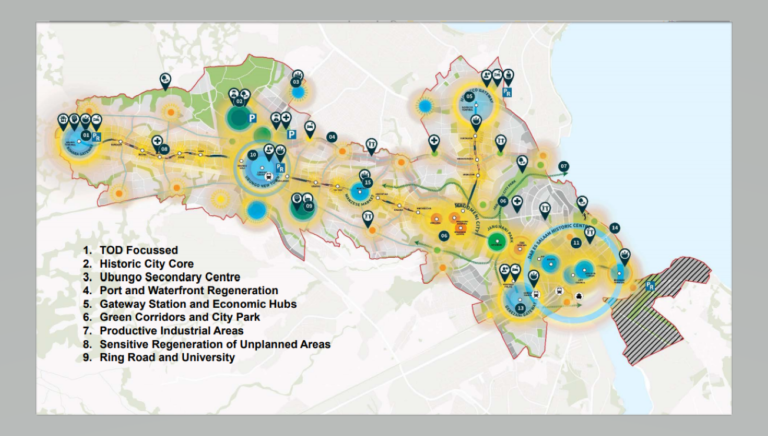Urban context
Inefficient form of city growth has led to a large peri-urban area developing on the outskirts of the metropolitan area, which has poor connections to infrastructure and public transport.
Growth of planned areas from the historic city core has occurred along the four arterial roads shown below. Some of the densest, poorest areas have developed along these roads such as Manzese and Urafiki. These largely unplanned areas have evolved as booming mixed-use areas with low-income housing alongside entrepreneurial business activities, markets and workshops.

The predominant land use across the city and the corridor, is unplanned residential development, which is the result of uncontrolled growth due in part to limited development controls and guidance. The current development model neither coordinates nor supports sufficient infrastructure and housing to accommodate the forecast 250,000 people arriving annually.
Radial spokes of commercial development emanate from the city’s historic core, which tends to direct most peak flow activity into the congested centre and creates a tidal flow out to the suburbs at the end of each working day. The city has a radial layout emanating from its historic nucleus on the waterfront. Four key routes define the city’s approach, including Morogoro Road, Bagamoyo Road, Kilwa Road and Julius Nyerere Road. Each route has a distinctive strategic function and their conversion to planned BRT corridors is to be implemented over the 6 phases.
Corridor Development Strategy

The Corridor Development Strategy (CDS) focuses on Phase 1 BRT a 20km stretch of Morogoro Rd from city centre to Kimara, as well as two spurs to Gerezani and to Morocco. Looks at buffer of 2km around each of 32 stations. Strategic recommendations include:
- Maintain, expand and consolidate the City Centre – the extent of this should be no further than the edge Msimbazi River to cover the inner city, Kariakoo and Upanga. Investment in the historic city centre is critical as a gateway location into the country or even the continent.
- Creating a series of liveable corridor communities – focussed at the gradual and organic enhancement of the informal settlements and consolidating residential areas
- Create new hubs of development – this will alleviate congestion and provide alternative development centres for commercial and residential activity, helping to reverse the tidal flows associated with city’s present mono-centric structure. Denser development at BRT stations within the corridor such as Ubungo Second City, Kimara agricultural market trade centre, Gerezani Commercial Hub and Magomeni mixed use centre. Morocco, located between Msasani Peninsula and Mikocheni, has potential to be a new upmarket cluster of mixed used development.
- Urbanise industrial areas – by creating routes for public transport and cycling and pedestrians adding permeablity to an otherwise badly accessible waterfront. Strategy allows for gradual relocation and concentration of industrial/logistical businesses to the port cluster and to Bagamoyo, leaving scope for a new mixed use downtown waterfront development from Kivukoni to Gerezani rail station.
- Create a network of open and recreational space – park zones where limited recreational and educational uses would be permitted. This include the Msimbazi River Park Project. The congested central area should be replanned with civic space free from traffic.
Each of the Phase 1 BRT stations were assessed against their market potential, development readiness (extent of obstacles); and the quality and attractiveness of a place. They are categorised (embryonic, emerging and mature) to guide planning, policy and infrastructure investment decisions.N
Reading
PO-RALG 2018 Dar es Salaam Metropolitan Development Project Phase 1 Corridor Development Strategy Vol 1 Part A CDS Vision & Strategy 2018-2032
PO-RALG 2018 Dar es Salaam Metropolitan Development Project Phase 1 Corridor Development Strategy Vol 2 Baseline Assessment & Diagnosis of BRT corridor
